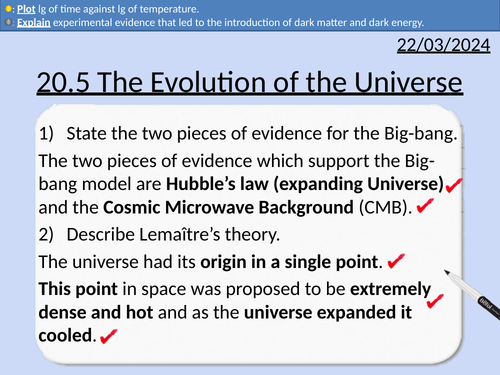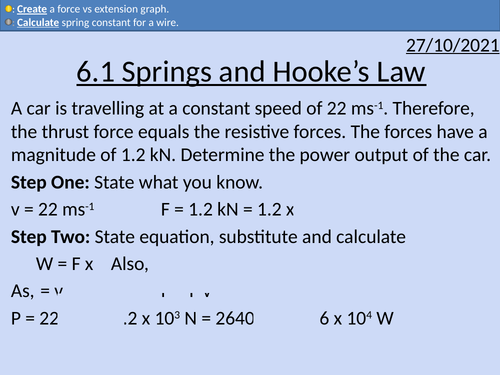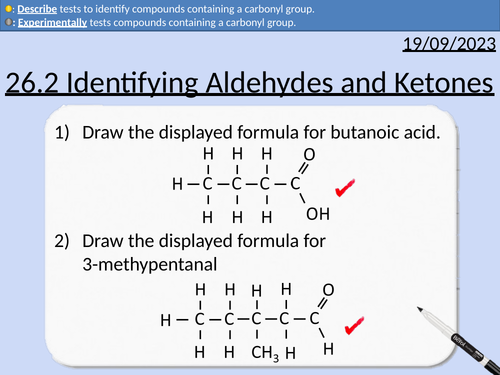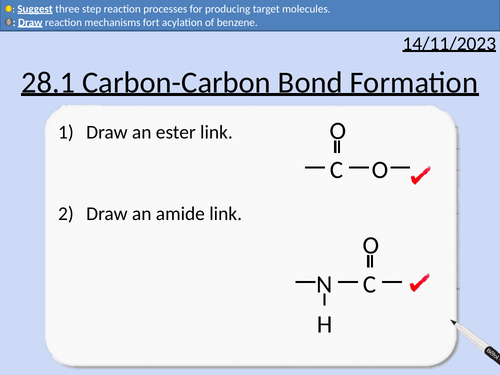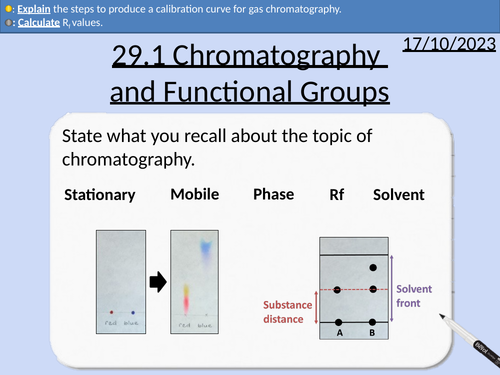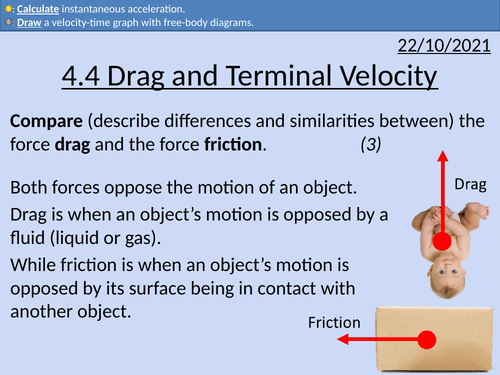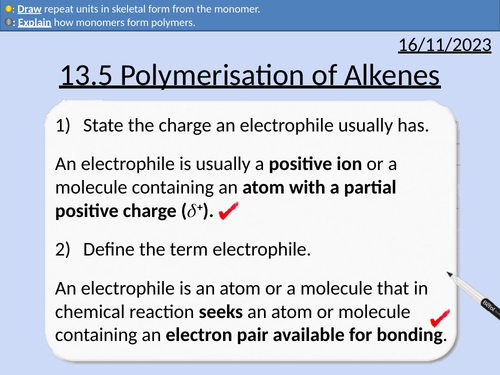454Uploads
138k+Views
61k+Downloads
All resources

OCR A level Physics: Evolution of the Universe
OCR A level Physics: 20.5 Evolution of the Universe
Module 5 Newtonian World and Astrophysics
This PowerPoint is a whole lesson included with student activities, animated answers, homework questions with answers provided.
This lesson covers:
The evolution of the Universe from the Big-bang to 13.7 billion years later
The composition of the Universe
Experimental evidence for dark matter
Experimental evidence for dark energy

GCSE Physics: Speakers and Microphones
This lesson presentations covers OCR Gateway Physics 9-1 P4.2.6 Speakers and Microphones.
Definition of sound waves.
Structure and operation of a speaker.
Fleming’s left hand rule.
Structure and operation of a microphone.
Electromagnetic induction.
Comparison of speakers and motors.
Comparison of microphone and generators.
Comparing microphones and speakers

OCR AS level Physics: Power and Efficiency
OCR AS level Physics: Power and Efficiency is a part of the Module 3: Work, Energy and Power.
Presentation come with worked examples, solutions and homeworks.

OCR AS level Physics: Springs and Hooke's Law
OCR AS level Physics: Springs and Hooke’s Law is a part of the Module 3: Materials.
Presentation come with worked examples, solutions and homeworks.

OCR AS level Physics: Kinetic and Gravitational Potential Energy
OCR AS level Physics: Kinetic and Gravitational Potential Energy is a part of the Module 3: Work, Energy and Power.
Presentation come with worked examples, solutions and homeworks.

OCR AS Chemistry: Nomenclature of Organic Compounds
OCR AS Chemistry: 11.2 Nomenclature of Organic Compounds
This PowerPoint is a whole lessons included with student activities, animated answers, homework questions with answers provided.
This lesson covers:
Aliphatic, alicyclic, and aromatic compounds.
Naming organic compounds
Drawing organic compounds
Functional Groups
Alkane
Alkene
Alkyne
Alcohols
Haloalkane
Aldehyde
Ketone
Carboxylic Acid
Ester
Amine
Nitrile

OCR AS Chemistry: Chemical Reactions of Alkanes
OCR AS Chemistry: 12.2 Chemical Reactions of Alkanes
This PowerPoint is a whole lessons included with student activities, animated answers, homework questions with answers provided.
This lesson covers:
Combustion reactions
Incomplete combustion reactions
Balancing equations
Using algebraic equations
Radical substitution reactions
Reaction mechanism for haloalkanes - Initiation, Propagation, and Termination
Monosubstituted (positional isomers) isomers

GCSE Physics: Nuclear Equations
This presentation covers OCR Gateway Physics 9-1 P6.1.3 Nuclear Equations
All presentations come with student activities and worked solutions.
Nuclear Notation - mass number and atomic number
Nuclear equations for emissions of:
Alpha radiation
Beta radiation
Gamma radiation

A level Chemistry: Further Practical Techniques
OCR A level Chemistry: 28.2 Further Practical Techniques
This PowerPoint is a whole lesson included with student activities, animated answers, homework questions with answers provided.
This lesson covers:
Filtration under reduced pressure
Purification through Recrystallisation
Preparation of Melting Point Sample
Melting point determination with an electric heater
Melting point determination with a Thiele tube
Bundle

OCR A level Physics: Capacitance
OCR A level Physics: Chapter 21 Capacitance is apart of the Module 6: Particle and Medical Physics
All presentations come with worked examples, solutions and homeworks.
21.1 Capacitors
21.2 Capacitors in circuits
21.3 Energy stored by capacitors
21.4 Discharging capacitors
21.5 Charging capacitors
21.6 Uses of capacitors
Electrical quantities, symbols, and units
SI prefixes and standard form
Definition of a capacitor
Structure of a capacitor
Calculating capacitance, charge, and potential difference.
Uses of capacitors in circuits.
Rules for capacitors in parallel (potential difference, charge, and capacitance).
Rules for capacitors in series (potential difference, charge, and capacitance).
Applying the rules in series and parallel.
Creating a circuit to calculate the charge stored on the capacitor.
Work done of a capacitor depends upon the initial potential difference and capacitance.
Work done is provided by the source of potential difference.
Deriving three equations for work done of a capacitor.
Exponential increase and exponential decay
Explaining how capacitors discharge through a resistor in parallel
Definition of time constant for a capacitor
Showing that time constant has units of seconds
Iterative method for finding how capacitors discharge
Using exponentials and logs.
Solving a differential equation (needed for A-level Maths).
Explaining how capacitors charge with a resistor in series
Explaining how 𝑉, 𝐼, or 𝑄, change with time 𝑡 for a charging capacitor.
Sketching graphs for 𝑉, 𝐼, or 𝑄, after time 𝑡 for a charging capacitor.
Calculating 𝑉, 𝐼, or 𝑄, change with time 𝑡 for a charging capacitor.
Calculating power output from a circuit containing a capacitor
A rectifier circuit - changing an alternating input to a smooth output
Bundle

OCR A level Physics: Electric Fields
OCR A level Physics: Chapter 22 Electric Fields is apart of the Module 6: Particle and Medical Physics
All presentations come with worked examples, solutions and homeworks.
22.1 Electric Fields
22.2 Coulomb’s Law
22.3 Uniform electric fields and capacitance
22.4 Charged particles in uniformed electric fields
22.5 Electric potential and energy
Electric field line pattern from point charges, uniformly charged objects, and capacitors.
Rules for electric field lines
Interacting field lines for attraction and repulsion
Detecting electric fields with a charged gold leaf
Definition of electric field strength
Explaining that electric field strength is a vector with magnitude and direction
Apply the equation for electric field strength
Electric force related to the product of charge and square of the separation
The constant of proportionality 𝑘
Permittivity of free space
Experiment for investigating Coulomb’s Law
Electric Field Strength and Coulomb’s Law
Liquid crystal displays (LCDs)
Electric field between two charged parallel plates
Deriving an equation for electric field strength of a parallel plate capacitor.
Accelerating charged particles in a uniformed electric field
Capacitance of a parallel plate capacitor with an insulating (dielectric) material - relative permittivity
Millikan’s experiment
Equations for constant acceleration
Maximum kinetic energy of a charged particle in a uniformed field
Sketching trajectories for charged particles in uniformed fields
Calculating velocities for horizontal and vertical components
Definition of electric potential energy
Definition of electric potential.
Definition of electric potential difference.
Using a force-distance graph to determine electric potential energy
Using electron-volts and joules in calculations
Capacitance of an isolated charged sphere
Bundle

GCSE OCR Physics: P7.1 Energy and Forces
All resources for P7.1 Work Done GCSE OCR Physics Gateway 9-1. Triple and combined (Higher and Foundation) is covered in this material.
Energy Stores and Energy Transfers
Work Done and Kinetic Energy
Work Done, Kinetic Energy and Thermal Energy
Work Done and Spring Energy
Gravitational Energy
Kinetic Energy
Kinetic and Gravitational Energy
Gravitational and Spring Energy
Gravitational Force and Energy

A level Chemistry: Identifying Aldehydes and Ketones
OCR A level Chemistry: 26.2 Identifying Aldehydes and Ketones
This PowerPoint is a whole lesson included with student activities, animated answers, homework questions with answers provided.
This lesson covers:
Testing for Carbonyl Groups
Brady’s reagent - 2,4-dinitrophenylhydrazine - 2,4-DNP
Distinguishing between Aldehydes and Ketones
Tollen’s reagent - silver nitrate in aqueous ammonia

A level Chemistry: Carbon-Carbon Bond Formation
This PowerPoint is a whole lesson included with student activities, animated answers, homework questions with answers provided.
This lesson covers:
Forming nitriles from haloalkanes
Forming nitriles from aldehydes and ketones
Forming amines from nitriles (reduction)
Forming carboxylic acids from nitriles (hydrolysis)
Friedel-Crafts alkylation of benzene
Acylation of benzene with acyl chloride

A level Chemistry: Chromatography and Functional Group Analysis
OCR A level Chemistry: 29.1 Chromatography and Functional Group Analysis
This PowerPoint is a whole lesson included with student activities, animated answers, homework questions with answers provided.
This lesson covers:
Thin layer chromatography (TLC)
Rf values
Gas chromatography (GC)
Gas chromatograms
Retention time and peak integrations
Calibration curves from retention time and relative peak area
Differentiation of functional groups: alkene, primary and secondary alcohols, aldehydes, cabonyl compounds, carboxylic acids, and haloalkes.

A level Chemistry: Nuclear Magnetic Resonance (NMR) Spectroscopy
OCR A level Chemistry: 29.2 Nuclear Magnetic Resonance (NMR) Spectroscopy
This PowerPoint is a whole lesson included with student activities, animated answers, homework questions with answers provided.
This lesson covers:
Nuclear Spin
Resonance
Tetramethylsilane (TMS)
Chemical Shift ẟ

OCR AS level Physics: Drag and Terminal Velocity
OCR AS level Physics: Drag and Terminal Velocity is a part of the Module 3: Forces and Motion
Presentation come with worked examples, solutions and homeworks.
Drag and speed relationship
Free body diagrams
Net forces and acceleration

GCSE Chemistry: Bond Energies and Energy Changes
This PowerPoint presentation with worked examples and student questions covers:
• Definition of bond energies
• Calculating bond energies per mole
• Calculating change in bond energies in reactions
• Determining if a reaction is exothermic or endothermic from the change in bond energy.

GCSE Chemistry: Transition Metals
This PowerPoint presentation with worked examples and student questions covers:
• Properties of transition metals gases
• Comparing transition metals with alkali metals
• Everyday applications of transition metals
• Transition metals as catalysts

OCR AS Chemistry: Polymerisation of Alkenes
OCR AS Chemistry: 13.5 Polymerisation of Alkenes
This PowerPoint is a whole lessons included with student activities, animated answers, homework questions with answers provided.
This lesson covers:
Monomers and repeat units
Addition Polymerisation for:
Polyethene
Polypropene
Polylactate
Polystyrene
Polyvinyl Chloride (PVC)
Environmental Concerns from polymers including:
Combustion of polymers
recycling PVC
biogradeable bioplastics
photodegradable polymers
feedstock recycling

